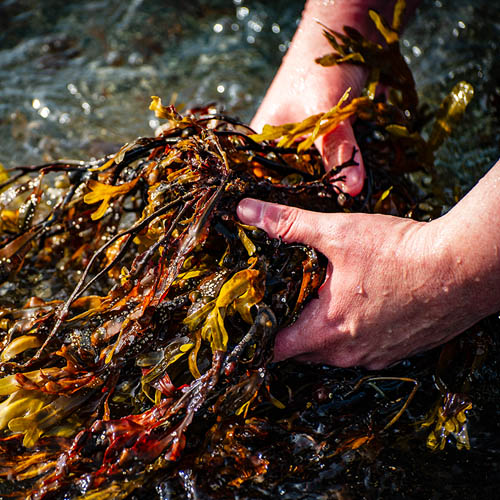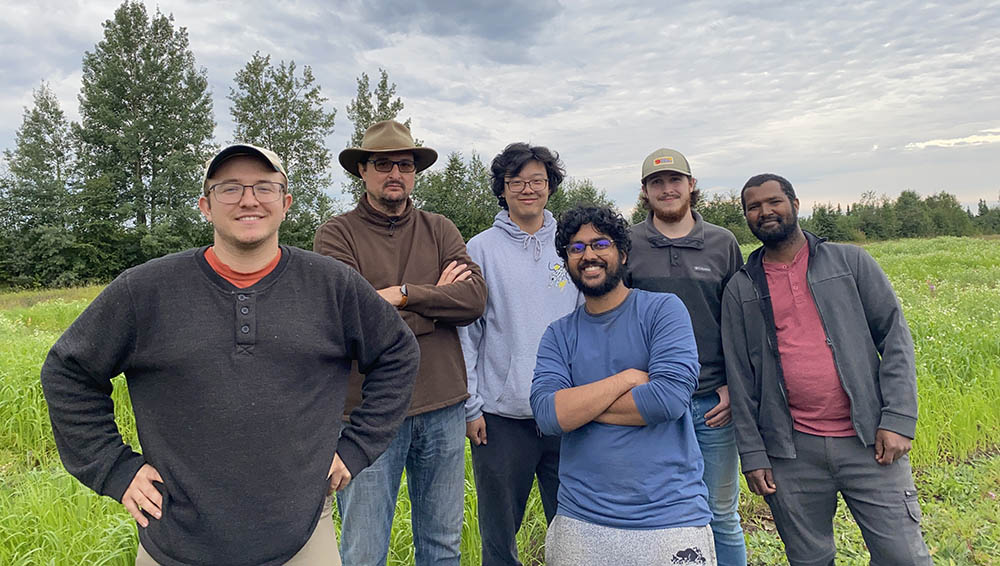Research Report: 2022
▼ Choose a report:

Powered by Research & Graduate Studies

Powered by Arts and Social Science

Powered by Science and the Environment


Caption: Ethan Garnier, Grenfell Campus graduate student; Dr. Adrian Unc, Grenfell Campus, Memorial University, project co-lead; Jason Choi, University of Waterloo technician; Max Locke, Grenfell Campus graduate student; Dr. Amana Kedir, Grenfell post-doc/project manager and Aman Dhindsa, University of Waterloo technician.
Original story by Chantal Vallis, Faculty of Environment, University of Waterloo
Grenfell Campus researchers are working with partners at the University of Waterloo to test what it takes to convert forests to productive farmland and explore how to make that transition equitable.
Dr. Adrian Unc of the Boreal Ecosystem Research Initiative at Grenfell Campus, Memorial University, is co-lead on the project, which is titled "BioSoil North: Local solutions for soil health resilience and mitigation of greenhouse gases" and being conducted in Labrador.
It's predicted that where we grow our food will have to shift north as increasing temperatures due to climate change make it too hot for crops to thrive near the equator. But moving our crops north, specifically into the Boreal Forest, is not as simple as it sounds.
The problem is that the soil is not as fertile. Plus, one loses a lot of historically stored carbon that goes back into the atmosphere - carbon that is essential for the soil's health. With these challenges in mind, researchers from the University of Waterloo, in partnership with Memorial University, are testing what it takes to sustainably convert the land and explore what the biggest return in crop productivity is for the least amount of greenhouse gas emissions.
"The goal of the project is to test land management systems and locally available materials that can improve the soil for agricultural use," says Maren Oelbermann, professor in the Faculty of Environment and the project co-lead. "The soil that is converted from forest to agriculture is acidic (low pH), so we are experimenting with treatments like biochar, fish and shrimp waste, and lime to correct the imbalance and optimize the production of crops like oats and peas."
The project includes three sites in Happy Valley-Goose Bay in Labrador - a subarctic region where the impact of climate change has already occurred, making it an ideal candidate for testing farming in the north.
"If you were to study agriculture in Southern Ontario or the Canadian Prairies, you are studying slight variations of things that have been done for over 100 years," says Aman Dhindsa, a graduate student completing his research with Dr. Oelbermann. "When you are doing agriculture in the subarctic - everything is novel. It's exciting because it's brand new," he continues. Dhindsa was a technician on the farms this summer and oversaw the farming experiments from set up to harvesting and took part in the newest farm's conversion.
While this project may be the first of its kind in North America, the researchers are quick to point out that they aren't the first people to farm the north. There were generations of colonial settlers that attempted to do the same across the north from Labrador to Alaska.
"We can't approach the project from just a scientific perspective," says Dhindsa. "We have to keep in mind how this work interacts with capitalism, the history of colonialism and food security. There is a lot of thought put into how this project can and should tackle systemic and deeply interconnected issues, and ensure that what is created is fair, inclusive and solves community problems together."
For decades, the Happy-Valley Goose Bay region, home to Innu of northern Labrador like the Sheshatshiu community, has experienced food security issues because of unreliable imports and a lack of farming infrastructure. Farming will become a significant tool in delivering food security and, most critically, food sovereignty to the north. The research farms involved in the project are owned by Innu, Inuit and settler farmers. The crops produced on the farms supply the local market as well as the communities in Nunatsiavut along the northern shore of Labrador. The hope is that this project will improve not only access to food but also contribute to some of the infrastructure development to enhance the overall economy.
Moving into the winter, the researchers will gear up to analyze the data and prepare for the next farming cycle. When they are back in the field next spring, they will start measuring greenhouse gas emissions in addition to soil fertility, to examine how that relates to crop productivity.
While this project is just one piece of the northern food security puzzle, it is also a model site for integrating food and climate change solutions relevant across the global north.
BioSoil North: Local solutions for soil health resilience and mitigation of greenhouse gases is funded by NSERC alliance.